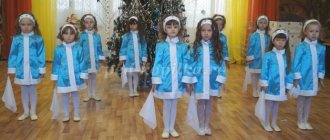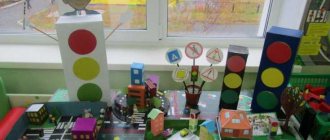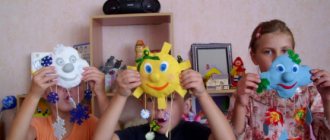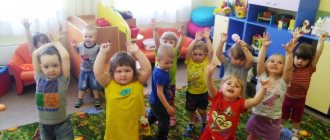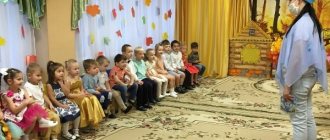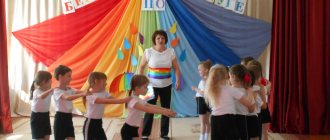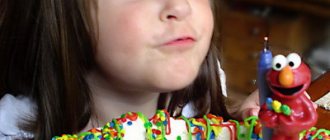Dancing with leaves is one of the most popular and in demand at autumn matinees in kindergarten. They are distinguished by accessibility, relevance and beauty.
You can cut the leaves yourself from cardboard or isolon. As a rule, maple or oak leaves are used. They have a beautiful shape and variations in color are possible: green, yellow, orange, red. But more complex options are also possible, for example, dancing with a mountain ash. At the end of the article I will provide a link to my templates for autumn leaves.
In addition, children of all ages can dance with leaves - from juniors to pre-schoolers. It can be like an entrance to a matinee, where there is an independent production.
Junior group. Dancing with leaves
Kids with leaves. Dance for children of primary preschool age to the composition “Oak leaves, maple leaves.” Performed by Lyayla Khismatullina.
Swing over me, My golden leaf. Oak leaves, maple leaves.
We are sitting behind a leaf, looking from behind a leaf. Oak leaves, maple leaves.
Suddenly a cheerful breeze wants to tear out my leaf. Oak leaves, maple leaves.
We won’t give you the leaflet, it will be useful to us ourselves. Oak leaves, maple leaves!
Junior group. You are a naughty leaf
Music and lyrics by Alla Evtodieva, song “You are a mischievous leaf.”
1. You naughty little leaf, fly after me, fly, fly, catch up with our children.
2. Our breeze blew, our leaf swayed, sway my golden leaf over me!
3. We lower the leaf, swing the leaves up and down, The legs will squat and dance with the leaves!
4. Where the children have leaves, they sleep quietly on their heads, A leaf sleeps, another sleeps, the mischievous wind sleeps too!
5. We are sitting behind a leaf, looking from behind a leaf, There are no kids, find them quickly! Where are the kids? Here they are!
6. Our leaves are spinning, we will dance with them. Our leaves are good, just like our babies!
7. Then the breeze woke up and the leaf rushed and rushed, Our legs ran, the tiny children ran!
8. We’ll collect a bouquet and go dancing again. Our bouquet is good, you won’t even find a better one! You simply won't find anything better! You won't find anything better!
Middle group. We're walking through the woods
Yulia Seliverstova's song is perfect for middle-aged children. Children's movements are more confident and clear, you can experiment with round dances and formations.
We walk through the forest and collect leaves! We’ll collect it when there’s an Autumn portrait in the bouquet! The leaf is yellow-yellow-yellow. Quickly take it into your hand and quietly let it go!
We walk through the forest and collect leaves! We’ll collect it when there’s an Autumn portrait in the bouquet! Let's quickly take the leaf, red-red-red, into your hand and quietly let it go!
We walk through the forest and collect leaves! We’ll collect it when there’s an Autumn portrait in the bouquet! A red leaf, a yellow leaf, quickly take it into your hands and bring it to a bouquet!
We walked through the forest and collected leaves. This is our bouquet. The best autumn portrait! Now let’s take the leaves, And make the guys happy, One two three four five, We’ll arrange a leaf fall!
Animated dances for children. Video
Animashki! Fun dances with simple movements. Ideal - 3 movements. Sometimes 6, no more. I'm not a choreographer and neither are most people. But we all love to dance! Because it's fun, it energizes us.
Dancing becomes even more interesting if you come up with a plot for it. For example.
Barbariki "Friendship"
I invented this dance myself! Music can be easily downloaded on the Internet, on VK or on any other site.
Introduction to the dance “Friendship” by Barbarika
I ask the children: is it good to be friends? funny? And if a friend feels bad, sad, what can we do for him? The children answer. Me: do you know that all children are a little kind wizards and can perform good miracles?
Let's create a miracle: turn on the sun ! Draw the sun with your hands. The heart clenches all the warmth into fists and now they throw it at their friends (sharply unclenching their hands), to the sides, again. And now they stretched their arms forward. Are your palms warmer? So a miracle happened!
The palms actually become warmer because we caused a rush of blood. But the children believe - it’s a miracle!
Watch the video at the end of the article and everything will become even clearer
The Bears
The song is familiar and loved by more than one generation. Let's get to the plot of the dance . We ask: why does summer and winter, day and night change? Why is this happening? Children explain that the earth rotates... And who spins it? do not know? I'll tell you: polar bears move the earth. But for some reason they were sad, and that’s why our weather is strange. let's help them
And we dance. Then the music is repeated with acceleration several times
If you need a photogram cut, I will send it to you for free. Contact me.
What attracts the bird
A good lead-in to the dance is to ask: do you know animals? What about the birds? And the fish? Show them to me. Now let's make it the same. We show moves and dance.
What to do on the verses? Before this dance, I usually introduce the children to the ribbon and teach them to walk in a looping step. When it works out, we start doing it cool, important, and it’s easier to say show off . (usually laughter here)
And in the song we perform movements at the chorus, and at the verses we show off - we walk in a circle with this meandering step, but with a show off.
Flash mob for children with movements
This is a more modern name for animation dances, dances with repetition of movements. Adults are actively involved in the children's flash mob. This is a great way to have a birthday party with virtually no props.
Flash mobs (animations, game dances) can easily be implemented into any scenario and will replace many competitions at a children's party, or diversify them. Especially if the children are active.
At a kindergarten or school graduation, or for a large group of children, animations are simply a lifesaver! Dancing brings joy to even kids and they repeat the movements with pleasure. This is very nice!
Middle group. Golden Day invites us
Children stand in 2 or 3 rows towards the auditorium. In the hands are leaves of isolon.
The golden day invites us, invites us to take a walk. A golden day offers us an offer to play.
CHORUS: Look like little lights, Lights-lights, Our multi-colored leaves, Our leaves-leaves.
We are like forest butterflies, flying through a clearing. The wings are painted leaves, and they are not afraid of the rain.
Can we shield ourselves from the rain with our little leaf? We can’t rush home - Under a leaf, like under an umbrella.
The breeze plays with us - All the leaves rustle, merrily change places and fly, fly, fly.
Basic positions and dance movements for preschoolers
Bekasova Svetlana
Basic positions and dance movements for preschoolers
Description of basic positions and dance movements for preschoolers
Starting leg positions
Main stand
– heels together, toes apart. For older children, the toes of the feet are turned as far as possible to the sides (in choreography - 1st position, for younger children - at an angle of 450 (“house”).
"Narrow Path"
- heels and toes together, feet parallel (for all age groups) in choreography - 6th position.
"Wide Path"
- feet - shoulder width apart, parallel.
Sit on your knees - lowering yourself low, sit on both knees. Knees pressed firmly to the floor.
• For older people:
2nd position
– feet shoulder-width apart, only the toes turned as far as possible to the sides.
3rd position
– the supporting leg is placed at an angle of 450, the heel of the non-supporting leg is placed in front of the middle of the foot of the supporting leg, also at an angle of 450.
4th position
– the supporting leg is placed in the same way as in the 3rd position. The non-supporting leg is placed forward the length of a small step at an angle of 450.
While in any of the positions described above, the legs should be kept straight, the gluteal muscles tense, the back straight, the stomach tucked, the weight of the body should be evenly distributed on both feet, resting on the toes. There is no need to require full eversion of the foot in positions from preschoolers. It is enough if the toes are turned at right angles.
Initial hand positions
At the bottom
– arms are lowered along the body.
Ahead
– arms extended at chest level (parallel to the floor).
Up
– arms raised as high as possible above your head. At a younger age, the height of the arms is arbitrary.
To the sides
– shoulders and arms form one straight line.
Hands may be open
– palms up (“towards the sun”).
Hands may be closed
– palms down (looking at the floor).
"Belt"
- palms on the waist, thumbs behind, the rest in front. Shoulders and elbows are slightly laid back.
"Fists on the side"
- fingers are slightly clenched into fists, which are placed on the waist with the back side inward.
"Shelf"
- arms bent at the elbows, folded in front of the chest. The right hand rests on the left hand (the hand of the right hand lies on the elbow of the left and vice versa).
"Matryoshka"
- hands (shelf), the index finger of the right (left) hand makes a “dimple" on the cheek of the same name. The left (right) palm supports the elbow of the other hand and is slightly pulled forward (in weight).
"Skirt"
- with the thumb, index and middle fingers (pinch) of both hands, take the edges of the skirt and spread your arms to the sides - up.
"Apron"
- grab the front of the skirt with a pinch on both sides and lift it up.
Behind the back
– hands are joined behind the back just below the waist. The back of the palm of the left hand lies in the right palm. The fingers are slightly clenched, the shoulders and elbows are pulled back.
Hand positions in pairs:
• Children stand nearby (look in one direction):
"Arrow"
- hands are joined in the “Forward” position; the name of the “arrow” changes depending on the angle: narrow, wide.
"Collars"
- hands are connected in the “Up” position. The girl's palm is placed underneath the palm of the boy's closed hand.
"Wattle"
- hands are connected crosswise.
"Bow"
- the same, but the elbows are rounded and raised forward - up, the arms are not tense.
"Sleigh"
— the boy stands in front of the girl with his back to her and gives her both hands back.
The girl stands facing the boy's back and takes his hands.
• Children stand with their shoulders of the same name together (looking in different directions):
"Lamb"
- the arms of the same name are connected crosswise at the elbows, the hand is clenched into a fist. Free hands in any of the listed positions.
"Spinner"
— hands of the same name are connected in the “Up” position.
Spin like a spinner - joining your hands in the “Spinner” position, move as if catching up with each other in place.
"Star"
(three or more children) – stand one after another, joining hands of the same name in the “Up” position.
Spin like a star - joining your hands in the “Star” position, move as if catching up with each other in place.
"Double Belt"
- if the children stand with their left shoulders facing each other, then with their left hands they clasp the partner’s waist from the front and vice versa. You can change the shoulders for each musical phrase.
• Children stand facing each other:
"Boat"
- hands are joined in the “sideways” position. They are open at chest level.
"Collars"
(narrow) - arms connected at the top, (wide) - to the sides - up.
Hand movements
"Breeze"
- smooth cross movements of the arms above the head. The work involves the shoulder, forearm, and hand.
"Ribbons"
- alternate smooth movements of the right and left hands up and down in front of you.
"Wings"
- smooth swinging movements with arms spread to the sides. It should be remembered that when raising the arms, the hands are lowered, and when lowering the “wing” arms, the elbows are slightly bent, the hands are expressively raised up.
"Singing Hands"
- from the “To the sides” position, with a soft movement, the hands are directed towards each other, as if collecting elastic air in front of them. The arms are also moved plastically to the sides. The body helps express the movement by leaning forward slightly and then bending back slightly.
"Motor"
- arms bent at the elbows in front of the chest, palms spinning around one another. Fast or slow.
Claps
"Okay"
- clapping with palms in front or behind (behind the back is performed with free, not tense, arms bent at the elbows, moving towards each other.
"Pancakes"
- on “one” - strike with the right palm on the left, on “two” - vice versa (the hands are relaxed, staccato, with a turn of the hand.
The claps can be loud or quiet, depending on the dynamics of the musical image.
"Plates"
- younger age - “shake off your palms”, older age - the palms of both hands imitate the sliding movements of orchestral cymbals: the right hand swings from top to bottom, the left hand moves from bottom to top.
"Tambourine"
- the left palm is a supporting one (like the lid of a tambourine, the fingers of the right hand hit it. Change the supporting hand. The blow is strong.
"Bells"
- active clapping overhead. The movement is bright, with a large scope of arms slightly bent at the elbows. This movement requires complete freedom of the upper shoulder girdle.
"Bells"
- small claps with straight fingers of one hand on the palm of the other. The blows are light and quiet. The arms can be bent at the elbows, straightened or raised to the side (to the right or left). There are possible options for “bells” that sound near the right ear or near the left.
"Catching mosquitoes"
- light, ringing claps with straight palms to the right, to the left of the body, above and below with arms bent at the elbows.
Claps in pairs:
"Wall"
- the palms of the hands bent at the elbows (in front) go towards the partner’s hands. The clap is performed in the middle of the distance between the children.
"Big Tambourine"
- one of the partners alternately holds open their palms with their elbows bent or arms extended forward, and the other hits them with their palms.
"Cross"
- the technique of execution is the same as in “Tambourine”, only the partners’ hands move crosswise (right to right and vice versa).
Types of step
Calm walking
(walk) – the step begins with the toe of the extended right (left) leg, the toe is turned to the side. The amplitude and length of the step are small. Hand movement is arbitrary (can be in any position).
Full foot step
(stomping) - performed with very little forward movement: the knees are slightly bent, the body is straight, the legs are placed on the entire foot with a slight stomp, they are almost not lifted from the floor, but they are not shuffled either. The child moves as if “on wheels”; hands can be placed on the belt with fists.
Round dance step
– this type of step is used in round dances. It differs from a simple step in its great smoothness and determination. Good posture and a raised head give the movement an aspirational character. The movement is associated with music of a leisurely, calm nature.
Added round dance step (without changing the supporting leg)
- on “one” - a small step from the toe of the right (left) foot, on “two” - the toe of the other foot is placed against the heel of the supporting foot, etc.
Added round dance step (with alternating change of supporting leg)
– rhythmic step pattern: 2 eighths, a quarter. On “one” - a long step from the toe of the right (left) foot, and on “and” - placing the left (right) toe to the heel of the supporting leg. On “two” - step in place from the right (left) foot. On the next beat, move from the other foot.
Quadrille step
– on “one” - step with the right (left) foot, on “two” - a light sliding kick with the heel of the other foot next to the supporting one. After the heel strike, the non-support leg extends forward, starting the next step. This step can be performed with a slight half-squat on the count of two.
High step
– the leg is not carried forward, but is bent at the knee and raised up at an angle of 900. The toe is pulled down as far as possible or the foot is parallel to the floor) using an “iron”. This is a step in place or moving forward (in the form of a cockerel, horse).
Step with a flood in place
– at “one time” they take a step in place with their left foot next to their right; on “two” - stomping with the right foot in front of the left, without transferring the weight of the body to it. Then on “one” step in the place of the right one, placing it next to the left one; on “two” - left foot in front of right; everything repeats itself from the beginning. The emphasis constantly falls on the stomp (on “two”).
Variable pitch
– performed for 2 measures in a two-beat measure or 1 measure in a four-beat measure. The step is based on a round dance step. On “one” and “two” of the 1st measure - long alternating steps from the toe of the right (left) foot. On “one” and “two” of the 2nd measure - three short alternating steps from the toe of the other foot. There is a pause on “and”. The next step begins with the toe of the left foot.
Side step
– to “one” - to the right (to the left, to “two” - the left (right) foot is placed on the supporting leg. Toes are together or apart, depending on the starting position (“narrow path” or main stance).
Side fall
– for “one” - a lateral step from the toe of the right (left) foot, the knee bends (like a small squat). On “two” - the toe of the other leg is placed against the supporting heel from behind, at the same time the knee of the right (left) leg is straightened. The “falling” element can be performed in place at a “point” or with a rotation around its axis (“clock”).
• Step on toes:
Springy step
– this is a “spring” with movement along the entire foot.
sneaking step
- this is a “spring” with advancement on the pads and low half-toes (the image of a doll, ballerina, etc.). the movement is performed only in the preparatory group.
Side step (“cross”
) - “once” - step to the side from the right (left) foot. On “two” - the left (right) leg is placed crosswise in front of it.
Step forward and backward (“pigtail”)
– a round dance step, only the legs are placed not at an angle of 450 to the right or left, but crosswise in front of the right or left. When moving this step back, the left foot is placed behind the right and vice versa.
Mincing step (“floating”)
– a smooth round dance step moving forward (backwards) on the toes. When performing it, only the leg lifts are bent. Performed at an older age.
Jumping
• On one leg:
"Dot"
- initial position of the legs - basic stance, arms in any position. After the push, land at the same point, placing your foot first on the toe, then on the entire foot. The other leg (non-supporting) is bent at the knee and laid back. Change the supporting leg.
"Watch"
- the technique is the same, only the jump is performed with a rotation around its axis. The supporting leg rotates evenly (like a clock hand) in a circle. For 8 jumps, the child must make a full rotation - 3600.
On “one, two” - left shoulder forward,
On “three, four” - with your back,
At “five, six” - with the right shoulder,
At “seven, eight” - with your face.
"Ladder"
- the technique is the same as at the “point”, but moving forward or backward by a certain number of jumps
"Fence"
- side jump to the right (on the right) or to the left (on the left leg). There are as many jumps as there are boards in the fence.
"Sun"
- the technique is the same as in the “point”, only moving along a circle of any diameter (“around the sun”).
• On two legs:
Jump
– alternate jumping on the right and left leg.
The amplitude of the jump depends on the nature of the music. It can be performed in place, moving forward or backward, as well as rotating around its axis (“clockwise”).
Jumping with throwing the legs back - one “one” - a “point” jump with the supporting leg, at the same time the non-supporting leg bends at the knee and is thrown back, heel up. The non-supporting leg can be suspended or placed behind the toe with the heel up. To “two” – change of supporting leg.
"Happy Legs"
(jumps with legs thrown forward) - then the right and toe legs are alternately often thrown forward, as if boasting to the audience. The toe of the foot is pointed down towards the floor. Arms to the sides, palms facing forward with the inside.
"Rocking chair"
- starting position - legs together. Then the right leg is brought forward a little and, as it were, pushes the left leg back, then it is brought forward again, and the left one returns to its place. The movement is repeated continuously.
"Scissors"
- for “one” - push, spread your legs to the sides and land in the
“Wide path”
. On “two” - push and cross your legs at the “point” in front (right foot in front of the left and vice versa when repeating).
"Cross"
- on “one” - push and cross your legs at the “point” (right leg in front, on “two” - the same thing, only the left leg is in front.
"Broom"
- the same as the “rocking chair”, only with a change of legs.
Side canter
- the same as the side step, only on a jump.
Gallop forward
– the technique is the same, only the movement is not to the side, but forward. At “one” - a push and the right (left) leg is carried forward, landing from the toe. The toe of the other foot is placed behind the heel of the supporting leg. On “two” - repetition.
"Rope"
- for “one” - a “point” jump on the left (right) leg, at the same time the other leg is placed behind and brought forward with a sliding movement of the toe along the floor. On “two” - everything is repeated on the right (left) leg. This jump can be performed either in place or moving forward.
Dance moves.
Starting position for all options (unless otherwise specified): legs in the main stance, arms in any position.
"Small swing"
- children stand holding hands and shaking them slightly from side to side.
"Big swing"
- the same thing, only they swing their arms strongly from side to side.
"Spring"
- standing still, squat easily, often, continuously. At the same time, the knees are slightly spread to the sides. The back is straight. This movement can be performed from the 6th position of the legs (on a “narrow path”). In this case, the knees of the legs do not spread.
Stomp - standing on your left foot, rhythmically stomp your right, slightly springing both.
"Three Floods"
(starting position - “Narrow path”) - step in place with the right foot, then the left and again the right, slightly stomping. Repeated from the left leg. The movement is performed rhythmically.
Stomp alternately with two feet
– the technique is the same, only for “one, and” - stomp with the right (left) foot, and for “two, and” - with the left (right) foot.
Flood combined with "dot"
- heel, toe of the non-supporting leg next to the supporting leg or at a distance of a small step in front.
Squatting - the technique is the same, only for “one” - squatting, for “two” - returning to the starting position. The amplitude depends on the age of the children. Full squats are performed only in the preparatory group. In this case, the heels of the feet are lifted off the floor, and the knees are spread apart, the back is straight and strong.
Half squat - performed in combination with a “point” - the heel or toe of the right (left) foot at a distance of a small step forward.
Half squat with body rotation
– do a half-squat, turning the body to the right (left) by 900. Turning the body straight, take the starting position.
"Picker":
1st option: the right leg is placed back on the toe, then brought forward to the heel and in place - three stomps.
2nd option: bend the right (left) leg at the knee and place it to the side on the toe, facing outward (heel up); At the same time, slightly bend the knee of your left (right) leg. Extending your right (left) leg straight, place it on your heel. Do a triple stomp, starting with the right (left) foot.
"Vest"
- for “one time”, half-squat with a “hands-on” clap with your arms bent at the elbows in front and above. On “two” - straighten up and place your right (left) foot at the “point” in front of the right on the heel. At the same time, extend your arms diagonally: the right one to the side and down, the left to the side and up. On the 2nd beat, do the same on the other foot.
"Samovarchik"
- for “one” - half-squat and clap hands with your arms bent at the elbows in front of your chest. On “two” - straighten up, extend your left hand to the side and up, with your right hand - slap the inside of the shin of your left leg, bent at the knee and raised up at an angle of 900.
"Herringbone"
- starting position: legs - “narrow path”, arms - “shelf”, “belt”, etc. On “one” - turn the feet (lifting your toes off the floor) to the right at an angle of 450. on “two” - the same heels . The movement can be performed both on straight legs and on a “spring”. The back is straight.
"Big Accordion"
- legs together. On “one” - spreading the toes out to the sides, on “two” – spreading the heels, on “three” – spreading the toes again, and on “four” – spreading the heels. Then return to the starting position in the same order.
"Stompers"
- starting position - legs together, slightly crouched, hands clenched into fists on the belt (akimbo). Often take turns stomping your feet in place.
"Lever"
- feet on the “narrow path”. At “one” - the right arm bends at the elbow and reaches up with the hand, bending at the knee, the first leg rises. On “and” - to the starting position.
Everything is on a spring.
Turn around yourself (circling) - standing facing the audience, begin to move to the right. It’s easy to turn on your toes around yourself and stop in the starting position.
"Comb"
- children stand in a checkerboard pattern. At a distance from each other, facing in the same direction.
1st option: first, the second line passes forward through the first, stopping slightly ahead. Then the first (being behind) passes forward through the second, stopping slightly ahead, etc.
Option 2: the first line moves backward, while the second line moves forward. Passing through each other, the ranks change places.
"Play with a handkerchief"
- holding the scarf (folded diagonally) by two corners in front of you at chest level, alternately lifting one or the other corner of the scarf.
• Dance movements for boys 6-7 years old:
"Goat"
- starting position - the right leg stands in front of the left, arms crossed in front of the chest. This movement is performed while jumping. Jumping on your left foot, stomp your right foot hard. On the count of “one” - the arms open in an arc to the sides and upwards (the fists are slightly clenched and raised up), on the count of “two” - they return to their original position.
"Happy Legs"
- back-crouching position. The legs are often, sharply “thrown” forward one by one. Returning to the starting position, the leg rests with its toe on the floor.
"Goose Step"
- starting position - in a half-squat, feet on the “narrow path”, walk widely in a half-squat on a “spring”. Swing your arms back and forth with your elbows bent. Watch your posture. The duration of the movement is no more than 8 beats.
"Top"
- leaning on the floor with the palm of your right hand, stretching your body and legs diagonally to the left, move in a “mincing” run around your axis (like describing a full circle with a compass). Left hand - arbitrary.
Kneel - go down on your right knee, left leg bent in the form of a chair. The foot of the left leg is at the knee of the right leg.
Bow
"Russian bow"
— starting position of the legs: 4th position.
Bend your right arm at the elbow and touch your left shoulder with the fingers of your right hand. Straightening your right arm, lower it down in front of you along the arc path, while simultaneously tilting your body forward.
Constructions
Column
– children stand one after another, in the same direction, keeping intervals between each other.
Line
– children stand next to each other, in the same direction, keeping intervals between each other.
Chain
– children stand half-turned one after another, holding hands.
Middle group. Dance with rowan
Girls of the middle group dance with a sprig of rowan. Song “There is a shadow on the path”, lyrics by Elena Blagina.
On the path there is shadow-shadow-shadow, Solar net. Through the tyn, through the fence, a branch bent.
I’ll come running, I’ll gallop, I’ll stand up on my toes! I’ll grab the branch by the braid and get the berries!
Chorus: Berries, berries, rowan berries. Berries, berries, rowan berries.
I’ll sit by the fence, and carefully string a rowan berry onto the silk.
Put on your bitter beads, become smart, branch! On the path there is shadow-shadow-shadow, Solar net.
Dance "Snowflakes" for the New Year middle group
this dance of girls for the New Year with particular ease; with frequent training, they will cope with all the characteristic movements without much difficulty.
But you need to start with choosing costumes. A suitable option that does not require much hassle would be to select a white dress for each girl, which is decorated with tinsel or paper snowflakes are attached to them.
Preschoolers can perform this dance to any of the following songs:
- "Silver Snowflakes";
- Tchaikovsky “Dance of the Snowflakes”;
- “A blizzard is swirling.”
Having selected the musical accompaniment, you can move on to studying dance sequences, which include a number of movements:
- whirling;
- running in circles;
- wave your arms.
Senior group. Entrance to the matinee with leaves
The guys in the older group dance to the song “Dance with Autumn.” Song author Tatyana Petrova, arrangement Alexander Zorin, performer Alina Afanasova.
Look at the leaf - it’s burning like a lantern. The leaf wants to dance - He flies in the dance with us!
We put the foot on the toe and knock everything with the heel. We will add smooth gestures, And then we will spin.
The Beauty Queen invited us to dance. She gave me a leaf, traces of autumn everywhere...
Autumn in polka circles with us, Sings a song merrily. Today we will all become friends with our autumn round dance.
Dance "Dolls" for the New Year middle group
Kindergarteners can also reproduce this dance without much difficulty, since all the movements are simple. Most often, this choreographic work is performed by girls, they wear identical dresses (you should think about sewing or renting in advance) and multi-colored wigs (similar to Malvina).
In such costumes, a newly formed choreographic ensemble can perform to numerous musical compositions, but today Zhenya Lyubich’s song “Lullaby of Silence” is very popular. You can also find many songs from unknown artists called “Doll”.
Among the characteristic movements the following are noted:
- stamping;
- whirling;
- clapping hands;
- jumping.
Preparatory group. Dance "Falling Leaves".
The older the children, the more complex the movements and dances. The preparatory group dances to the song “It’s not easy to rain today.” Author - N. Naydenova, arrangement - Alexander Zorin, vocals - Marina Melnik.
Today the rain is not simple, today the rain is golden! He is not aquatic at all, there is not a single cloud.
Leaf fall, leaf fall! Leaves are spinning, flying, Leaves are flying in the wind, Falling leaves!
Autumn day is so good, How many leaves can you collect! Golden large bouquet - Greetings from autumn to us!
Leaf fall, leaf fall! Leaves are spinning, flying, Leaves are flying in the wind, Falling leaves!
Preparatory group. Exercise with leaves “Birch tree, rowan tree”
Amazing composition by Dmitry Kabalevsky to the words of Anton Prishelets.
Now a birch tree, now a rowan tree, A willow bush over the river: My native land, forever loved, Where else can you find one like this?! My native land, forever beloved, Where else can you find something like this?! Where else can you find one like this?!
From the seas to the high mountains, In the middle of our native latitudes, The roads are always running, And they are calling forward. Everyone is running, the roads are running, And they are calling forward. And they call forward.
The valleys are filled with the sun, and wherever you look, the native land, forever loved, is all in bloom, like a spring garden. My native land, forever beloved, is in full bloom like a spring garden. Everything is blooming like a spring garden.
Our golden childhood is getting brighter every day, Under a happy star We live in our native land! Under a lucky star We live in our native land! We live in our native land!
